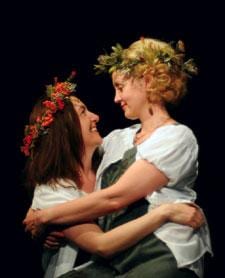The Fringe Festival has a well-deserved reputation as the launch pad for successful plays. Hit shows like ’Da Kink In My Hair and The Drowsy Chaperone may have started out small, but popularity at the Fringe encouraged their creators — and investors — to take another look.
Then there’s My Mother’s Lesbian Jewish Wiccan Wedding, a son’s story of his mom coming out, falling in love and, well, getting married. The show, written by husband and wife duo David Hein and Irene Carl Sankoff, was a huge crowd pleaser at this year’s festival — so much so that it’s managed to jump to the top of Toronto’s theatrical heap as a full-blown Mirvish production. It’s an almost unheard-of break for this straight take on lesbian marriage — kind of like making the transition from folksy backyard nuptials to Charles and Di at St Paul’s Cathedral.
“It’s one of those cases of working for 15 years and it suddenly falls in your lap,” says Sankoff. The sudden success of their play may seem like an overnight sensation, but she and Hein had been plugging it out on the acting and music scene long before David Mirvish nodded his stately pate in their direction.
Sharing a season with theatrical juggernauts like The Sound of Music and Stomp is heady stuff for the couple, but aside from a few new musical numbers and some fleshed-out back story, they’ve kept faith with the true life story of Hein’s mom. Audience-pleasing ditties like “You Don’t Need a Penis” and “Don’t Take Your Lesbian Moms to Hooters” remain intact, as does the message of support and love from a son and daughter-in-law for their gay mother. The cast and production team also returns, albeit still a little shocked at their show’s windfall.
“We just went down to the Panasonic and they have the cartoons that I drew on the posters there,” marvels Hein. “Then we went to see The Sound of Music and we’re on the TVs there and everything. It’s amazing.”
One major change from the original production is that Sankoff will no longer be playing herself, but a new character named Michelle. Is it odd to perform alongside someone who’s playing out your life onstage? “Not a bit,” she laughs. “It finally gave me a chance to dance around in the scene at Hooters, which, frankly, I was jealous of the first time around.”

 Why you can trust Xtra
Why you can trust Xtra


